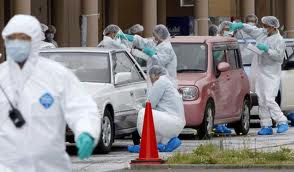2 Nuclear Plant Workers Exceed Radiation Limit; Much More Becoming Tested
Jumat, 03 Juni 2011 by Android Blackberry
Two nuclear plant workers have exceeded Japan’s radiation exposure limit for men and other people who toiled without sufficient protection in the earliest days of the disaster could show high levels as well, the government and plant operator stated Friday.
 |
| Exceed Radiation Limit; |
The two control room operators at the Fukushima Daiichi plant are the very first men to surpass the government-set limit. About 40 workers are being tested further following preliminary findings showed high exposures, TEPCO spokesman Junichi Matsumoto stated.
The two men aren't showing immediate wellness issues but have an increased lifetime risk of cancer. TEPCO will take care of their long-term health monitoring, he said.
Doctors at the National Institute of Radiological Sciences examined them and said the two men do not call for current health treatment and can live normally, Matsumoto said.
Workers have been fighting to get the Fukushima Dai-ichi plant under control since the March 11 earthquake and tsunami knocked out power and crucial cooling systems, largely melting the cores of 3 reactors. Several explosions have scattered highly radioactive debris around the plant and leaked radiactivity into the environment around it.
The two men, one in his 30s and the other in his 40s, were responsible for the central control room for Unit three and 4 reactors the day the disasters struck and inside the days that followed. About 150 other control room operators worked early inside the crisis and are being examined.
Overexposed workers most likely inhaled radioactive particles while battling the initial crisis without having sufficiently covering themselves with masks and radiation-proof gear, Matsumoto said.
“Monitoring of internal exposures has been slow. I’m afraid we’ll see additional men and women exceeding 250 millisieverts,” Goshi Hosono, director of the government’s crisis management taskforce, urging TEPCO to speed up monitoring of workers’ well being and take appopriate steps.
Soon right after the tsunami damaged the plant, the government raised the limit for men to 250 millisieverts from the earlier 100 millisieverts so workers could tackle the emergency.
Total exposures of the two male workers may perhaps be as high as 580 millisieverts-nearly 1,000 abdominal X rays-if they had been practically entirely irradiated inside the 1st two days, when a 1st explosion occurred at the plant, Matsumoto stated.
The total exposure would depend on no matter whether they wore masks, their location inside the facility as well as other elements. Officials are still examining details to finalize the results.
A massive single whole-body exposure of 500 millisieverts could decrease lymphocyte cells in many people, which would compromise their immune systems.
The exposure limit for females is considerably lower to stay clear of harming a fetus of any pregnant worker. The limit for ladies certified to function in controlled locations is five millisievert for three months, as well as the cap for other girls is 1 millisievert. Two girls within the first category have exceeded that limit, and two in the second category.
The two men, and the 4 females whose exposures had been disclosed earlier, have been removed from working at the plant.
TEPCO has been criticized for not fully disclosing the extent of radiation exposures by the plant workers or their working conditions.
When TEPCO revealed the preliminary outcomes on the two men this week, the well being ministry ordered TEPCO to check exposure levels of everybody who worked closely with them and to eliminate them from plant duties.
TEPCO has promised to bring the plant under control by January, but fears are growing that was too optimistic.
TEPCO has been also struggling to contain tons of radioactive water leaking out of the damaged reactors, but the water that has pooled across the plant is now threatening to overflow temporary storage tanks, Matsumoto said.
Workers are scrambling to complete a reprocessing system by June 15 to ultimately reuse the water as coolant in the reactors. The schedule is really tight, as the water could start overflowing around June 20, or even earlier in case of heavy rain, Matsumoto stated.

